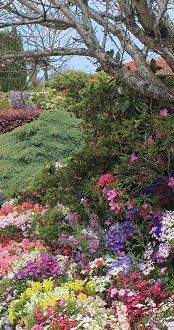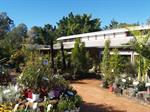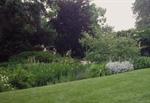Select the Right Plant for the Right Garden
Choosing the right plants for the right purpose is often the difference between a good garden designer and a not so good one. In order to do this effectively gardeners and landscapers have to have knowledge of how different elements of the environment impact upon plant growth, and particular types of plants.
Often the reason a plant fails to thrive in a given location is because of many factors combined. It is more difficult to try and modify the environment for plants than to choose the best plant for the site in the first place.
Learn to make better planting decisions
Study this comprehensive course to find out how to make the best plant choice from those available. Learn about all the different groups of plants and the key factors which influence their growth and how they can be used in the landscape. Find out how plants from turf grasses to trees are established, through planting techniques and site preparation, and maintained. Feel confident in making planting decisions.
 Study the selection and maintenance of garden plants
Study the selection and maintenance of garden plants
- Learn to choose the best plant for the garden design you are creating.
- Understand why certain plants are appropriate and others are not.
- Explore the criteria that make a big difference to garden design.
Content
The 10 lessons are:
1. Introduction
What to plant where, Plant selection, Plant varieties, Colourful year round foliage, Establishment (timing, soil preparation, plant size, planting technique), Maintenance programs, etc
2. Woody plants
Selecting woody plants, trees, shrubs, deciduous/semi deciduous/evergreen; flowering shrubs, Establishing woody plants, Planting procedure, Dealing with shade, etc
3. Windbreaks, hedges and screens
Plant selection, establishing windbreaks & screens, Trimming a hedge, etc
4. Alpine and water plants
Selecting & establishing alpines, Selecting water plants, Establishment & maintenance of water plants
5. Annual and herbaceous plants
Selecting annuals, Types of annuals (by height, flower, edge plants, dot plants, groundwork plants), types of bedding schemes, Planting seed or seedlings, Container culture, Selection & Establishment of herbaceous plants (Bulbs & Perennials), Maximizing flowering effect, etc
6. Turf
Varieties, Lawn mixes, What to grow where, Wildflower Meadows, Turf establishment, Soil Preparation, Seeding, Sodding, Stolonizing, Sprigging, Plugging, Mowing, Fertilising, etc
7. Maintenance
Fertilizing, Managing pH, Replacing plants, Pruning, Irrigation, Humidity, Mulch, Developing a maintenance Program,
8. Pest and disease control
Problem prevention, Non chemical control, Chemical control,
9. Weed control
Non chemical control, Chemical control, Safety, Alternative strategies.
10. Risk assessment
Identifying risk, Duty of care, Workplace safety, Protective clothing, Safety with tools, Significance of illness, etc
Duration: 100 hours
Aims
- Develop knowledge of the range of applications for and selection and establishment of horticultural plants.
- Develop knowledge in the establishment and maintenance of a range of woody plants, with different modes of growth, for different situations.
- Develop knowledge in selection, establishment, and maintenance of species suitable for hedges windbreaks and screens.
- Describe the cultivation of alpine and water plants.
- Describe the selection, cultivation, and maintenance of herbaceous plants.
- Develop knowledge in the selection, establishment and maintenance of turf and lawns.
- Develop knowledge in the maintenance and cultural requirements of herbaceous, woody, and other plants.
- Develop knowledge in the control of pests and diseases in horticultural situations.
- Develop knowledge in the management of weeds in horticultural situations.
- Develop skills in risk assessment.
 Good Plant Selection Saves Money and Time
Good Plant Selection Saves Money and Time If you choose an inappropriate plant for a position; you are creating a whole range of potential problems.
- It may take a lot longer to grow to full size
- It might never look as good as it could because it's growth might not be lush, it's flowering might not be prolific, and it might harbor ugly pests and diseases
- The likelihood of survival is diminished and the need for maintenance is increased; and this means added costs.
Plants that like wet soils look good when grown in the wet; but can look ugly when grown in the dry. Plants that like full sun may exhibit stronger foliage colour in full sun, but insipid, dull and unattractive growth when growing in shade.
This course will build your knowledge and understanding of what you should be planting where. Learn to choose your plants well and you will have a valuable skill for life!
Plants for Wet Soils

Many gardens have a wet spot where some plants simply won’t grow. One option is to improve the drainage; another is to choose plants that thrive in wet soil.
It’s important to know why the soil is wet
There’s always a reason for an area to be wet, and the types of plants you grow there should be chosen according to that reason.
It may be:
- a low spot that collects drainage from the rest of your property
- low ground that may occasionally flood
- an underground spring
- a septic outlet
- a drain outlet
- a broken drain pipe or water pipe
BEWARE
If the ground is wet because of a drain outlet or broken pipe, some plants can cause additional damage as their roots grow vigorously and widen the cracks. For this reason, avoid planting willows, poplars, figs and bamboos near buildings, underground pipes or paving.
Choosing the Right Plants
Some plants thrive in moist soil but only tolerate really wet soil for short periods. They are best suited to areas that only become very wet after heavy rain. They include Maples, Buddleia, Catalpa, Fatsia, Birch, Dogwoods, Lilac, Liquidambar, English Oak, Blueberry, Mulberry, Magnolia grandiflora and Holly.
In permanently wet soil, choose plants are naturally adapted to growing in swamps and beside creeks. If you have a large garden, trees with deep, spreading roots that soak up the water are ideal. These include Melaleucas (especially M. quinquenervia and M. stypheloides), Casuarinas (especially the Swamp She-oak, Allocasuarina glauca and the River Oak, Casuarina cunninghamiana), Tupelo (Nyssa sylvatica), Poplars, Willows, Bottlebrush (especially Callistemon salignus and C. viminalis), Water Gum (Tristaniopsis laurina) and Metasequoia.
Smaller plants for wet spots include ferns, reeds and sedges.
Other good plants to use may include:
- Arum lilies (Zantedeschia ‘Marshmallow’, ‘White Gnome’, ‘White Mischief’, ‘Green Goddess’) -Lush green soft foliage with pure white, ‘pink’ or green tones flowers
- Canna lilies (Canna) -Clump forming erect growing foliage plant with brightly colour flowers.
- Colocasia esculenta ‘Black Magic’ Large heart shaped dark green-black leaves.
- Crinum campanulatum -Prefers periodic dry spells, Crinum produce large white or pink blooms from spring to summer.
- Daylilies (Hemerocallis) -Tussock foliage with brightly coloured day-long blossoms.
- Himilayan Weeping Bamboo (Drepanostachum falcatum) -Graceful weeping habit, shade loving and moisture requiring non-invasive bamboo.
- Lobelia ‘Queen Victoria’ -Scarlet red flowers on tall dark red foliage.
- Louisiana iris (Iris sp.) -Varied coloured forms
- Papyrus (Cyperus alternifolius) -Water loving sedges that have attractive ‘tops’ that radiate outwards in a disc pattern.
- Pitcher plants (Sarracenia spp.) -Trumpet-like leaves that are carnivorous. Needs very damp situations.
- Spider lily (Hymenocallis) -Soft green foliage with clear white blooms from spring to summer.
How This Course Could Benefit You
This course is likely to be of value to people who have an interest in garden design and landscaping. It will also appeal to anyone with a general interest in growing plants. People who take this course are most likely those working in or aspiring to work in:
- Garden Design
- Landscaping
- Gardening
- Horticulture
- Parks & Gardens
- Botanical Gardens
- Garden Maintenance
The course will also be of value to people wishing to start a garden design or general gardening business.
WHAT NEXT?
Register to Study - Go to “It’s Easy to Enrol” box at the top of the page and you can enrol now.
or
Get Advice – Email us at info@acsedu.co.uk OR
Use our FREE COUNSELLING SERVICE to contact a tutor
CLICK TO CONTACT US